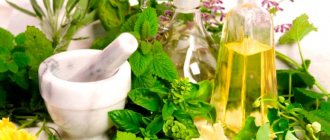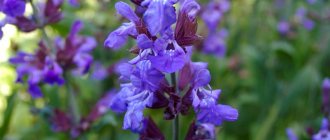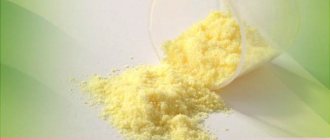What is sage
Sage is a perennial subshrub or herbaceous plant of the Lamiaceae family, reaching a height of 20-70 cm. It began to spread throughout the world from the Mediterranean countries, and currently there are about 900 species in total. Salvia officinalis is used in folk medicine.
It is recommended to use dried sage leaves for conception.
All parts of the plant are used for drying; leaves are collected up to 3 times per season, flowers - from July to September. The raw materials are dried in the shade outside, in a ventilated area. The shelf life in dry form is 2 years.
Chemical composition
The stem, leaves and flowers of sage contain:
- flavonoids;
- ursolic acid;
- essential oils;
- tannins;
- oleanolic acid;
- vitamin A;
- vitamin C;
- B vitamins;
- linoleic acid glycerides;
- calcium;
- manganese;
- iron;
- zinc;
- magnesium.
Where can I buy
You can buy sage at a pharmacy or a specialized online store.
Average price:
- leaf herbal tea 50 g - 50 rubles;
- sage tea drink 50 g - 40 rubles;
- sage herb 50 g - 60 rub.
Medicinal properties of sage
The rich chemical composition of the plant has the following positive effects on the human body:
- anti-inflammatory - effectively copes with diseases of the oral cavity, throat and bronchi;
- disinfectant;
- restorative;
- improves the functioning of the nervous system;
- increases the body's energy reserves;
- strengthens the immune system;
- stimulates hair growth and prevents hair loss;
- improves blood circulation in the scalp;
- normalizes the activity of the endocrine system;
- effectively copes with excessive sweating of the feet;
- fights depression;
- promotes the process of liver cell restoration;
- eliminates inflammation of the gallbladder;
- effectively copes with various gastrointestinal diseases.
How does sage affect a woman’s body for conception?
Sage is actively used at the pregnancy planning stage, especially if a couple has problems conceiving.
The medicinal plant has the following positive effects on the female body (in descending order):
- antiseptic effect - substances contained in the plant inhibit the growth of bacteria and destroy them;
- anti-inflammatory effect - external use of sage-based products soothes irritated mucous membranes, eliminates swelling and accelerates regeneration processes;
- normalizes hormonal levels, which is important for pregnancy.
How does sage help you get pregnant? It works in several directions, which we will discuss below.
Thickening of the endometrium
After ovulation, the egg travels through the tubes into the uterine cavity to attach to the endometrium. When fertilization occurs, the endometrial layer becomes thicker, intertwines with the placenta and supports the nutrition of the embryo.
But if there is not enough estrogen in the female body, this process is disrupted. The endometrial layer becomes thinner, making it more difficult for the zygote to attach and hold onto it. Even if this happens, in the future this condition can lead to spontaneous abortion.
Phytoestrogens can increase the thickness of the endometrium by activating the growth of small blood vessels and glandular tissue.
In consultation with a specialist, find out how to drink sage correctly for conception, as this will allow you to “increase” the thickness of the endometrium by 5 mm. For comparison, the popular drug “Divigel” promotes the growth of the inner uterine layer by only a few millimeters.
Estrogen production
Often problems with conception arise due to an irregular menstrual cycle. The occurrence of ovulation is influenced by estrogens - a whole group of hormones, and not just one substance, as some believe. The role of estrogen is in the formation of follicles in the ovaries and the activation of ovulation.
Sage phytoestrogens do not affect the production of their own hormones, but at the same time have an effect similar to estradiol on the woman’s reproductive system.
Formation of follicles
Their formation directly depends on the amount of estrogen content. This group of hormones activates their growth, formation and rupture of the dominant follicle, from which an egg ready for fertilization emerges.
The deficiency of these hormones leads to the fact that the dominant follicle skips all the necessary stages of maturation and does not rupture. As a result, the egg cannot be released from the ovary, and ovulation does not occur.
Phytoestrogens affect the receptors of the female reproductive system, provoking the growth of follicles. But before you take sage for pregnancy, you need to take hormone tests and check the amount of estrogen in the blood. An increased amount of estradiol often leads to premature maturation of the follicle and the release of an inferior egg.
You can take sage during pregnancy only as prescribed by a doctor.
Normalization of the menstrual cycle
The main guarantee of successful conception is timely ovulation and a sufficient endometrial layer for “planting” the zygote. Taking sage promotes the formation of a normal menstrual cycle, reduces pain during menstruation, and in case of scanty menstrual discharge, it will eliminate blockage of blood vessels.
In addition, taking the drug sage improves mood, relieves dizziness and prevents appetite from running wild during menstruation.
Treatment of inflammation
Another obstacle to pregnancy is inflammatory processes affecting the reproductive system. Thrush, cervical erosion and other infectious and inflammatory pathologies can be successfully cured with the help of sage.
It is effective as part of complex therapy for inflammation of the vagina and external genitalia. The plant also has a pronounced anti-inflammatory effect, preventing the appearance of fungi and stopping erosion processes, restoring the natural microflora.
How to take - treatment regimen
Salvia officinalis has many medicinal properties. Rich content of the plant:
- antiseptic and anti-inflammatory essential oils;
- vitamins B, C, E, P;
- camphor; phosphoric, nicotinic acids;
- tannins;
- thujone.
The beneficial effect of sage on the female body is expressed in the rejuvenation of the reproductive system and its improvement for successful conception. In addition, the medicinal herb is used at the onset of menopause to make hormonal changes in the female body easier. Also, men are prescribed the use of this medicinal herb if they suspect pathologies of the genital organs.
Sage is prescribed for both prevention and treatment of identified problems associated with infertility. This plant improves the reproductive health of both future parents, and the basis for this healing effect is the high content of phytoestrogens - analogues of a group of human hormones. They are responsible for the successful development of the fertilized egg in women, and for healthy spermatogenesis in men.
Estrogens
The plant normalizes the estrogen content necessary for better sperm acceptance and easier passage of sperm through the genital tract.
A common reason for prescribing the plant is insufficient thickness of the endometrium. Phytoestrogens can increase it and, accordingly, the likelihood of successful attachment of the fetus to the uterine wall.
It is used to stimulate follicle growth, which also normalizes the entire process of ovarian function. However, if a hormone test confirms the maturation and rupture of the follicle as normal, then the plant should not be used, since its use will disrupt the natural course of the cycle.
The plant reduces pain during the bleeding phase and promotes myometrial regeneration in subsequent stages. Sage is also widely used to neutralize menopausal symptoms.
Normal testosterone production is especially important for men when planning conception, as it is responsible for the quality of semen.
Sage phytoestrogens in the male body are converted into testosterone and actively work to increase reproductive abilities: they fight sperm stagnation, edema, and infections.
Sage has an active effect on spermatogenesis due to:
- restarting metabolic processes in the testicles;
- activation of the formation of new spermatozoa;
- improving blood microcirculation in the genitals;
- normalization of the patency of the vas deferens.
The use of sage for medicinal purposes must be approved by the attending physician, because there are a number of diseases that are an absolute contraindication to the use of this herb:
- Endometriosis;
- Neoplasms of any origin in the uterus and ovaries;
- Hypertension;
- Acute kidney disease;
- Hypothyroidism;
- Allergy.
Thus, an increase in estrogen production worsens hormonal balance, and a lack of progesterone can provoke the formation of cysts.
The most widely used extract from the plant is essential oil. The leaves and flowers of sage are used to make it. A common subspecies - meadow - does not have healing properties, therefore it is not used in medicine.
Leaves
The leaves of the grass have a gray-green tint with translucent fibers. For medicinal purposes, leaves without cuttings are used, dried for 3 months. The resulting dried mass is used to make either herbal tea or an infusion. Fresh leaves are also used; due to their antimicrobial properties, they are used in cleaning teeth.
The flowers have a distinct aroma and are perfect for producing antiseptic essential oil.
Stems
The stem is not used separately, only in its full form with leaves and flowers. Bunches of unpeeled stems are poured with boiling water, kept under pressure to soften the tetrahedral structure of the stem, and then used as a poultice.
The plant has a root structure rich in branches of varying degrees of woodiness. Oil is squeezed out of the roots, which, unlike essential oil, contains less thujone, a substance that causes food poisoning.
- decoction;
- infusion;
- poultices;
- oil, including essential oil;
- in rare cases, juice.
Any form of medicinal use of this herb helps to improve the main indicators of women's health: a stable menstrual cycle, the body's readiness for possible conception, the optimal state of the reproductive organs for pregnancy and childbirth.
Infusion
Taking the plant to increase the chances of getting pregnant is justified in cases where studies conducted by a doctor show a reduced level of female hormones.
Sage infusion is a more concentrated drink than decoction, and therefore is drunk less often and in smaller portions. The most common dosage regimen is a tablespoon 2 times a day, an hour after meals.
However, options for individual calculation of the daily dose are possible, taking into account the test results.
To stimulate the production of hormones necessary for pregnancy (follicle-stimulating, luteinizing, etc.), sage can be used in two ways:
- Taking a decoction or infusion orally (brewed according to instructions and consumed 3-4 times during the day according to the scheme).
- Massage with essential oil (rubbing into the skin of the lower abdomen).
During the douching procedure, a decoction is used, less often an infusion (low concentration). At the pregnancy planning stage, it can help cope with inflammation due to thrush, infections and damage to the vaginal mucosa. In this case, douching can be replaced with sitz baths.
If the medicinal plant is intended to eliminate a woman’s hormonal problems that affect conception, then douching should be done immediately before sex.
The best option for purchasing a plant is at a pharmacy or specialty store.
Sage can be either a loose collection or powder, or bagged tea. A quality certificate provided by the point of sale will guarantee that the harvest is correctly collected and dried.
Instructions for use usually suggest daily brewing and three times a day, but the best way is to take it according to the regimen prescribed by your doctor. The specialist will take into account the individual characteristics of the body and calculate the optimal dose of leaves.
Taking sage by women over 40 years of age helps support the endocrine system and delay the onset of menopause.
Planning pregnancy is not limited only to medicinal herbs, and therefore requires consultation with a doctor.
Only a specialist can approve the use of this herb as a therapy to support the production of sex hormones. Rich in phytoestrogens, sage can significantly improve the functioning of a woman’s genitourinary system.
Sage is able to stimulate the production of the main male hormone - testosterone.
Its intake has a positive effect on the entire male reproductive system, helping to improve the process of spermatogenesis, normalize the functioning of the gonads, and increase libido. In addition, herbal baths have a calming effect and are effective in treating the problem of premature ejaculation.
For the decoction, dry leaves are used, which are brewed in the ratio “1 teaspoon of the mixture per 1 glass of boiling water.” The decoction must be made daily, filtered, and taken before meals 4-5 times a day. Thus, a glass of fresh decoction is enough for a day when consumed in 50 ml portions.
In pharmacies you can find sage not only in bulk, but also in individual filter bags designed for one-time brewing. A glass of infusion from one package is consumed twice a day (half a serving), but not at night.
Sage can eliminate hormonal imbalance only with drug treatment, so its use must be agreed with a doctor. If there are no contraindications, then the following infusion options can be used to improve hormonal levels:
- An infusion prepared from 2 tablespoons of crushed leaves in a water bath - 3 times a day
- Alcohol tincture, aged for a month until thickened - 2 teaspoons a day.
Sage in combination with other herbs is often found in various herbal mixtures, from general strengthening to increasing sexual desire.
Linden leaves, verbena, ginseng, lemongrass, etc. go well with it. Any herbal mixture must be brewed according to the instructions and consumed a couple of hours after eating.
The regimen of use is prescribed by a doctor and requires careful adherence to avoid possible harm to the body. To monitor the results, your doctor may order an ultrasound and hormone tests.
Taking sage begins at the end of menstruation and lasts 2 weeks. After stopping the use of the medicinal decoction, it is necessary to monitor the onset of pregnancy.
The medicinal plant is used for a wide range of diseases, including those associated with the inability to conceive. Taking the plant actively helps to improve the genitourinary systems of women and men and normalize processes important for pregnancy. Proper use according to the regimen gives results within a couple of months after the start of treatment.
Despite the fact that sage is a herbal remedy, a woman should definitely consult with her doctor before using it. The fact is that the subshrub, as a source of natural plant hormones, can enhance the effect of hormonal drugs prescribed for the treatment of infertility, and a hormonal imbalance will arise, which in itself will become an additional obstacle to the cherished goal - pregnancy. The dosage should be calculated individually, based on data from laboratory tests of the hormonal profile.
Most often, for women who want to become mothers, sage is suitable in the form of decoctions, infusions, douching and insertion of tampons. Sometimes a combination of application methods is recommended.
Regardless of the chosen method, a woman should start taking sage preparations only after the end of her next menstruation. During menstruation, the intake is canceled completely. The first day in the treatment regimen is the first day after the end of menstrual bleeding.
You should continue to take sage only until ovulation occurs, that is, in the first phase of the cycle. Ovulation usually occurs in the middle of the cycle; with a 28-day cycle it should be expected on the 14th day, with a 30-day cycle - on the 15th day, etc.
From the moment of ovulation, you should stop taking sage, as it increases the tone of the uterus, which is undesirable for the normal process of implantation of the fertilized egg, if fertilization has taken place.
Improving hormonal levels with sage
There are many reasons why a woman fails to get pregnant. They can be divided into several levels:
- Morphological - inflammation of the ovaries and uterus, abnormal structure of the uterus, pronounced anatomical defects.
- Functional - all organs have the correct structure and are intact, but at the same time there are problems in their work.
- Morphofunctional - combine morphological and functional reasons.
The main purpose of taking a sage-based drug in this case is to cover the low activity of female sex hormones with the help of phytoestrogens. But it should be taken into account that in this case the plant is used only as an additional remedy as part of complex therapy. Moreover, before using such phytoestrogens, it is necessary to conduct a study of the patient’s hormonal background in advance.
Sage for conception for men
The male body contains a small amount of estrogens. If the ratio of female and male genital organs is not observed, then this negatively affects the reproductive abilities of the body. Sage does not significantly affect a man's hormonal levels, and there is no scientific evidence that the plant worsens or improves sperm quality.
Sage enhances libido as it acts as a natural aphrodisiac. It can be used as an essential oil, for this it is recommended to take clary sage.
Also plant:
- increases blood circulation in the scrotum;
- prevents the development of inflammatory processes;
- activates metabolic processes in the testicles;
- fights stagnation in the vas deferens.
To improve male sexual health, experts advise drinking an infusion (55 ml three times a day) or a decoction (½ glass before breakfast or bedtime). The duration of the appointment is determined by the specialist.
How to take sage to get pregnant
In folk medicine, sage is used in the form of dried leaves for conception. But what is the correct way to drink it and how much to get pregnant? Only the treating gynecologist can answer this question, based on the test results and the patient’s condition.
Common sage treatments for conception include:
- taking decoction and infusion;
- use of sitz baths;
- douching;
- introduction of therapeutic tampons.
Reception scheme
There is a certain scheme for using sage for pregnancy:
- You should start taking the medicinal plant on the last day of menstruation;
- duration of the course until the expected day of ovulation (day 10-14 of the cycle);
- after ovulation, sage cannot be used, as it increases the tone of the uterus and interferes with the fixation of the fertilized egg.
There is no need to drink sage in advance for ovulation and pregnancy. It has a hemostatic effect, complicates the process of endometrial rejection, provoking inflammation.
The duration of therapy is from 8 to 10 days. How to take sage to get pregnant if nothing worked the first time? Can be repeated 2 more times, and the total duration of the course should not exceed three months. It is recommended to take a break of at least 30 days between courses. This pattern cannot be ignored, as it can lead to serious health problems.
Photo of infusion with sage
Infusion
Ingredients:
- crushed sage leaves - 1 tsp;
- water - 1 glass.
How to prepare: Pour boiling water over the raw material, leave to steep for 2 hours. Strain.
How to use: Drink ⅓ glass three times a day, focusing on the menstrual cycle.
Decoction
Ingredients:
- sage - 2 tsp;
- water - 2 glasses.
How to prepare: Pour hot water over the raw material, place it on the stove and boil for 1 minute. Cool, strain through cheesecloth.
How to use: Drink 60 ml three times a day.
Recipe with sage and knotweed for infertility
Ingredients:
- knotweed - 1 tsp;
- sage - 2 tbsp;
- water - 500 ml.
How to prepare: Pour boiling water over the herbs, then place the composition in a water bath for 10 minutes. Cool and strain.
How to use: Take half a glass of decoction 20 minutes before meals.
Douching
Douching with sage infusion will help cope with inflammation. The duration of use depends on the degree of inflammation. As a rule, the procedure is performed twice a day - morning and evening.
Take a shower before douching. Then 1 tbsp. Pour warm infusion or decoction into a syringe and carefully insert it inside.
Douching with sage for pregnancy is advisable in the following cases:
- strengthening mucous tissues;
- elimination of itching, burning;
- stimulation of the body's protective functions;
- elimination of inflammatory processes.
Only a doctor should prescribe douching with sage. It should be understood that any douching causes disruption of the vaginal microflora and often provokes the development of inflammatory processes.
Baths and tampons
In some cases, sitz baths or tampons soaked in sage infusion will help cope with infectious diseases. They can only be used after consulting a doctor.
The duration of the bath is no more than 10 minutes. To prepare it, dilute a glass of infusion in 5 liters of water. The use of a tampon is limited to half an hour.
The systematicity and duration of the course of procedures depends on the stage of the disease. It should be taken into account that it will not be possible to completely recover with herbal medicine alone; complex therapy will be required.
How to drink sage for conception: recipes and dosage regimen for infertility
How to drink sage for conception? First of all, it is necessary to undergo a comprehensive gynecological examination and be sure to take a hormone test. Only after this the doctor prescribes a course of therapy with this herb. It is important to follow the treatment regimen and not suppress the growth of progesterone, which is extremely important for the implantation of the fertilized egg and its development.
- Treatment of infertility with sage (more about the plant) in folk medicine is a well-known fact. In herbalists you can find various recipes for conception. In addition to decoctions and infusions, healers recommend drinking sage juice with salt.
- For example, in ancient Egypt this herb was often given to married women in the form of tea. In gynecology, herbal medicine has recently become increasingly popular.
- However, not all gynecologists of traditional medicine trust sage, as well as other well-known phytohormones - red brush and hogweed. And when prescribing hormone replacement therapy, doctors more often choose synthetic drugs.
There is also an opinion that too much importance is attached to treatment with folk remedies in our country. Some herbs are becoming "brands". Gynecologists urge you to remain vigilant and not self-medicate.
How does the herb work?
The causes of infertility can be very different - congenital and acquired pathologies of the reproductive system, hormonal imbalance and lack of ovulation, dysfunction of the genital organs, inflammatory processes, neurotic disorders, stress. Sage for pregnancy is prescribed only after the cause of infertility has been established, in complex therapy with other drugs. This herb is taken to normalize hormonal levels. When will sage be useful?
- To increase estrogen levels. Sage is a natural estrogen. What role does this hormone play in the menstrual cycle? Under the influence of estrogen, the follicle grows and bursts approximately in the middle of the cycle, and a mature egg is released from the ovary into the fallopian tube. This process is called ovulation. Without ovulation, conception is not possible. Sage is essential for increasing estrogen levels, follicle maturation and egg release.
- For endometrial growth. The cause of infertility may be hypoplasia - thin endometrium (the mucous wall of the uterine body lining its cavity). Depending on the phase of the cycle, the endometrium changes its thickness; it is sensitive to hormonal levels. If a woman does not have enough estrogen in her body, the endometrium will be thin throughout the entire menstrual cycle. This in turn reduces the possibility of implantation of the fertilized egg into the uterine wall. Sage, as a natural source of estrogen, helps increase their level and increase the thickness of the endometrium. The positive effect of the herb on endometrial growth has been confirmed in scientific medicine.
Sage is often taken in combination with other herbs. It is their combination that gives the therapeutic effect. What herbs are phytohormones?
- Borovaya uterus. This is a phytohormone (progesterone). The herb is used to treat cervical erosion, mastopathy, inflammation of the genital organs, adhesions of the fallopian tubes, ovarian cysts, uterine fibroids, endometriosis and other women's diseases. Borovaya uterus has antitumor, anti-inflammatory, immunostimulating, antispasmodic effects. This plant also helps with menstrual irregularities, painful periods, amenorrhea, and menopause. Combining sage and boron uterus for conception gives a positive result if you adhere to the dosage regimen on certain days of the cycle. Read more about the use of boron uterus in gynecology in our other article.
- Red brush. This is a well-known “female” hormonal herb. It is prescribed for the same diagnoses as the hog uterus. The herb also has an immunostimulating, adaptogenic effect. Women may be prescribed it before planning a pregnancy to strengthen the body. This is a preventive measure for inflammation of the female reproductive system. Red brush is usually taken along with hogweed and sage. Read more about how to drink red brush correctly in our other article.
- Linden. Many people know that linden flowers are an effective remedy for colds, with a strong anti-inflammatory and diaphoretic effect. But the grass also contains phytohormones that are beneficial for women’s health. Linden is recommended to be used in combination with sage.
What are the contraindications of the herb? Ingestion during pregnancy and lactation is strictly prohibited.
Since sage is a phytohormone, it cannot be taken independently for any hormonal disorders, thyroid diseases, or cancer diagnoses.
You should not take the herb at the same time as synthetic hormones, as their levels may increase significantly. This will lead to disruption of the menstrual cycle. Also contraindicated are acute kidney disease and grass allergies.
How to properly prepare infusions and decoctions from herbs? It is equally important to know how to take sage in order to get pregnant. Let us emphasize once again: only a gynecologist can prescribe a course of treatment with phytohormones after an examination.
You can drink sage for infertility in the form of a decoction or infusion. What is the difference?
How to brew a decoction
- Take 1 tsp. herbs.
- Pour a glass of boiling water.
- Boil for about 1 minute.
- Insist for half an hour.
How to prepare an infusion
- Take 1 tsp. herbs.
- Pour a glass of boiling water.
- Leave for 2 hours.
Before use, strain the decoction and infusion. Drink 1/3 glass 4 times a day before meals. In some recipes, the dosage of the herb is increased (for 1 glass of boiling water, take 1 tablespoon of raw material). The question of increasing the dosage should be discussed with your doctor.
How to take sage to get pregnant? First of all, it is necessary to confirm that the cause of infertility is precisely ovulation disorders. Before starting a course of treatment, you must remember the following:
- undergo a gynecological examination;
- do an ultrasound;
- Based on examinations, hormone tests, and basal temperature measurements, the doctor determines on what day of the cycle the egg matures.
It is after determining this day that a course of treatment is prescribed. What are the admission rules?
- Start drinking the infusion on the 3rd or 4th day of your period.
- Continue drinking until the egg matures to its maximum.
- The course of treatment depends on the length of the menstrual cycle.
- For example, with a classic 28-day cycle, you start drinking grass on day 4 and finish on day 12 of the cycle.
- For a short cycle (21 days): drink from days 4 to 10.
- For a long cycle (more than 32 days): drink from days 4 to 17.
It is forbidden to take the herb:
- in the first days of menstruation, since the herb can stop the discharge and lead to stagnation, inflammation due to poor cleansing of the walls of the uterus;
- after ovulation, since this can provoke uterine tone, the fertilized egg will not attach to the wall.
Often, errors occur when determining the day of egg maturation. Therefore, if in the first cycle there is no desired result, the course of treatment with phytohormones is repeated for the next two cycles. After three months of treatment you need to take a break. A course of treatment 3 times a year is allowed.
Douching with sage is prescribed for thrush. It is also used in the complex treatment of infertility with phytohormones. However, the procedure is not as harmless as it seems at first glance. In gynecology, there are opposing opinions regarding the treatment of gynecological problems with douching. In what cases is this procedure contraindicated?
- Acute inflammatory processes of the pelvic organs.
- After childbirth and abortion.
- During menstruation.
- Before visiting a doctor.
Douching with sage for infertility is carried out only as prescribed by a doctor. It is important to observe the duration of the course and dosage (weak concentration of the solution) so as not to cause irritation and an allergic reaction. It is also necessary to remember that douching leads to disruption of the vaginal microflora and can provoke inflammation of the genital organs, including fungal and bacterial ones.
Who did sage help get pregnant? Unfortunately, there are no reliable medical statistics on the successful treatment of infertility with sage. And the herb itself is not included in the list of first drugs.
Reviews can be read on various women's forums, where the problem of infertility and “home-grown” methods of treating it are actively discussed. Opinions vary widely.
There are also negative reviews and warnings from women who experienced a number of side effects after taking sage. The most common of these are menstrual cycle disruptions and delayed periods.
In joyful anticipation, women conduct home pregnancy tests - and are bitterly disappointed. After a menstrual cycle failure, it takes a long time to restore hormonal balance.
Nevertheless, even negative reviews and warnings from doctors do not stop women. You often read: “I prescribed sage to myself.”
The opinion of doctors on the issue of treating infertility with herbal remedies is divided into: pros and cons. In scientific medicine, infertility is not considered an independent disease. It is associated with the general condition of the female body, the immune system, the health of the reproductive system, and hormones.
A comprehensive examination of a woman is required to make such a diagnosis. An equally important factor is neurotic disorders. Neurosis associated with the inability to get pregnant is a common diagnosis that is not advertised.
Gynecologists urge: a strong desire to have a child should not cloud a woman’s mind. While domestic gynecologists can include phytohormones in complex therapy, foreign gynecologists are more likely to criticize this method.
Doctors pay attention to possible side effects when taking the herb:
- pain and cramps in the lower abdomen;
- disruptions of the menstrual cycle;
- heavy or, conversely, scanty periods;
- jumps in basal temperature;
- nausea, vomiting, stool disorders;
- headache;
- formation of functional cysts due to rapid growth of follicles.
If a long-awaited pregnancy occurs while taking phytohormones, abrupt discontinuation of treatment is not recommended. This is due to the fact that hormone withdrawal can lead to a sharp spike in the hormonal system.
Interaction with herbs
Sage is often used in combination with other medicinal herbs that increase the healing effects of plants. Below is a list of herbs with phytohormones:
- Linden - Linden flowers are an excellent remedy for colds; they have a powerful anti-inflammatory and diaphoretic effect. The grass also contains phytohormones that are beneficial for women’s health. Experts advise taking linden in combination with sage.
- Borovaya uterus - this herb contains the phytohormone progesterone. Borovaya uterus is used to treat cervical erosion, mastopathy, uterine fibroids, fallopian tube adhesions, etc. This herb has anti-inflammatory, antitumor, antispasmodic and immunostimulating effects. The plant also normalizes the menstrual cycle, copes with painful menstruation and amenorrhea, and improves the condition during menopause. The combined use of sage and boron uterus has a positive effect on the processes of conceiving a child, if you strictly follow the regimen for taking these remedies.
- Red brush is a popular “female” hormonal herb that is used for the same diseases as hogweed. The plant has an immunostimulating, adaptogenic effect. It can be recommended to women at the stage of pregnancy planning in order to increase the body's protective properties. The herb is also used to prevent inflammation of the female reproductive system. Typically, red brush is used together with sage and hogweed.
Recipes for preparing medicinal products
The practice of traditional treatment, aimed at solving the problem of long-awaited conception, often resorts to the help of medicinal sage. Based on these raw materials, a variety of healing products are made at home.
Sage + linden
Linden contains natural estrogens, so in combination with sage raw materials, an effective remedy is obtained that allows you to solve the problem of infertility caused by a lack of this hormone.
To make the infusion, place 10 g of sage leaves and linden blossom in a faience mug. Brew with boiling water - 220 ml. After cooling, the drink is filtered.
Sage + hogweed
The use of sage raw materials and boron uterus for conception is considered the most effective method. It is important to take into account that their reception is carried out according to a certain algorithm.
Sage remedies stimulate ovulation. They increase the concentration of estrogens, which normalize reproductive functions.
It is recommended to use an infusion of 1 tbsp at home. l. crushed dried sage herb. Steam the raw materials with boiling water - 200-250 ml.
After pumping, cooled, drink 50 ml every six hours, starting from 4-8 days (depending on the length of the menstrual cycle) after the start of menstruation. You can take sage-linden infusion 1 tbsp. l. every eight hours.
Since sage is necessary to activate the ripening of follicles, stop drinking it when ovulation occurs. From this moment on, the boron uterus is taken until the onset of menstruation.
The benefit of the boron uterus is expressed in replenishing the deficiency of progesterone necessary for conception. It also helps to secure the fertilized egg in the uterus, reduces toxicosis, and prevents the threat of miscarriage.
You will need dried crushed grass of the hogweed. Place 10 grams of raw materials in a thermos. Steam with slightly cooled (90-95 degrees) boiling water, which you will need one glass. After an hour, the infusion should be filtered using a two-layer gauze cloth. 1 tbsp. l. consume before meals 3-4 times a day.
Article for you:
How to treat varicose veins with horse chestnut
If pregnancy occurs, you should consult with your doctor about the need to continue taking boron uterus in order to ensure the survival of the embryo.
Storage, expiration date
It is not recommended to store the infusion and decoction. It is advisable to prepare a fresh portion of the product daily. If necessary, the broth can be left in the refrigerator in a closed glass container for a day.
Contraindications
Despite the benefits of sage for conception, in certain cases its use can be harmful. It is prohibited to use the plant in the following cases:
- childhood;
- long-term use - more than 3 months, as this leads to the accumulation in the body of substances that negatively affect the functioning of the kidneys;
- exceeding the recommended dosage;
- presence of polycystic ovary syndrome;
- inflammatory processes in the kidneys;
- early and late stages of pregnancy (in the first case, a miscarriage may occur, in the second - placental abruption);
- breastfeeding - sage helps stop lactation;
- individual intolerance;
- recent childbirth or abortion;
- increased estrogen levels;
- amenorrhea;
- oncology;
- acute inflammatory processes of the pelvic organs;
- the first days of menstruation;
- conducting a gynecological examination in the near future.
Infusions and decoctions should be drunk with caution in case of hypertension and hypotension.
Among the side effects:
- pain and cramps in the lower abdomen;
- menstrual irregularities;
- migraine;
- change in the nature of discharge: heavy or scanty;
- sudden changes in basal temperature;
- diarrhea;
- nausea and vomiting;
- the appearance of functional cysts due to the sharp growth of follicles.
If the desired pregnancy has occurred, it is not recommended to immediately stop drinking sage, as this can lead to a hormonal surge and, as a result, miscarriage. At the same time, some experts recommend canceling it immediately. What is the best thing to do in this case? Consult your doctor.
In all other cases, it is recommended to consult a doctor.
Waiting for 2 lines on the test after taking sage
Dosage regimen for women
There are several regimens for taking sage for conception, depending on the type of pathology.
A suitable regimen must be chosen together with your doctor to get maximum results. Infusion and decoction of sage are taken orally, they can also be used for douching.
As a rule, the infusion and decoction are taken 50 ml four times a day, but other regimens are possible if the doctor deems it necessary. You need to take the medicine at regular intervals, preferably at the same hours. Regular use is the basis for effective treatment of hormonal diseases.
We recommend reading: Ginkgo biloba - benefits and harm
Anovulatory cycles
If a woman does not ovulate, but her periods come more or less regularly, the drug is taken from the first day of the cycle (the day of the start of menstruation) until the 11th or 12th day according to the above regimen. The course is repeated for 2 or 3 months, after which a blood test is performed to determine the level of estrogen and the next cycle of taking the herb is not carried out. If there is a positive result, but it is not enough, the course of treatment is repeated.
Irregular periods
If menstruation occurs irregularly, then the drug should be taken on the fifth day of the cycle. Usually at this point your period has ended or is close to ending. On the 11-12th day of the cycle, the intake is stopped. Repeat the procedure for 2-3 cycles, as in the previous case. The course of treatment lasts until menstruation stabilizes or the ineffectiveness of taking sage is determined.
Lack of menstruation
If a woman of reproductive age does not get her period, start taking sage on any convenient day, drink according to the above regimen for 11-12 days, then take a break of 2-3 weeks, then repeat. If menstruation occurs during treatment, the course begins again from the first day of the cycle.
Douching
This method is used for the treatment and prevention of inflammatory diseases of the vagina. To do this, take a medicinal decoction or infusion at room temperature into a rubber bulb or syringe, carefully insert the tip into the vagina and inject the medicine in a gentle stream. First you need to wash your genitals.
When taking sage for conception, it is necessary to conduct ovulation and pregnancy tests. After ovulation occurs (approximately 11-12 days of the cycle), you need to stop taking the drug. Pregnancy is a strict contraindication for taking sage.
Does sage help you get pregnant?
Doctors are unanimous in their opinion that sage is not a panacea for infertility, and it should only be taken as part of complex therapy.
Scientific research has shown that phytoestrogens act exactly on the same receptors as the body's hormones. However, their effect is rather weak in comparison with real estrogens. If we compare the strength of influence of these two components on the body, the proportion will be about 100 to 0.001-0.2. For this reason, monotherapy with sage most often does not bring any results.
Reviews
Veronica, obstetrician-gynecologist
Many women who are wondering how to get pregnant often use traditional medicine, namely, sage or hogweed. I do not recommend doing this, since there can be many reasons for problems with conception. First, you should take tests and undergo examinations, and only then select a suitable treatment regimen.
Inga, gynecologist
Whether it is possible to drink sage for conception or not - this should only be decided by a doctor based on the patient’s tests. If difficulties with conception arise due to inflammatory or infectious processes in the body, then first you need to eliminate them. It is also recommended to take folic acid and Proginova. In particularly severe cases, a procedure such as IVF may be necessary.
Susanna, 36 years old, housewife
I became pregnant with my first child without any problems, and my daughter was born. Therefore, it is not surprising that it was her son who wanted the second baby. I used all known ways to get pregnant with a boy, but nothing helped. I visited a gynecologist, took tests, and it turned out that I had gynecological problems. The doctor advised me to drink sage and prescribed appropriate therapy. And after 3 months I became pregnant.
Vitalina, 22 years old, student
My boyfriend and I have been wanting a child for a long time. I read on one forum that taking sage increases the chances of conception. To be honest, I didn’t really believe in it, but I still drank decoctions and infusions based on this plant. Within a month, pregnancy occurred. I don’t know if this is related to sage or not, but I didn’t have any health problems before.
Infertility is a serious disease that must be treated only with the help of specialists and after a full examination of both partners. Self-administration of various medicinal herbs can only aggravate the problem. The advisability of taking sage for infertility depends on the reason that caused this condition.
The right solution in such a situation is to contact a specialist. The doctor will prescribe tests and studies, an examination in a gynecological chair and an ultrasound. Based on the results obtained, an idea of the cause of infertility will be drawn up. Don’t waste time on self-medication, trust your doctors and then in the future you will be able to see the long-awaited 2 lines on a pregnancy test.
Admission rules for pregnancy
Many women are interested in how to take sage for conception. Before starting treatment, you must consult a doctor and get tested. If you have endometriosis, neoplasms in the uterus or ovaries, hypertension, hypothyroidism, or kidney pathologies, taking herbal products is prohibited.
In the absence of contraindications, the compositions can be used. The course begins after the end of menstruation. Duration of oral administration is 2 weeks. Based on the analysis results, we can talk about further use.
To stimulate ovulation
The medicinal herb improves the functioning of the ovaries, so the growth and maturation of follicles is restored. Accordingly, the process of egg release from the ovary is normalized as a result of timely rupture of the follicle. Decoctions and infusions should be used 3-4 times a day only if tests indicate disorders associated with the maturation and rupture of follicles.
They begin to take it orally in the first half of the cycle, when menstruation ends. You can additionally apply the essential oil of the plant to the skin of the lower abdomen. Rub in with light massaging movements.
To build up the endometrium
If the endometrium is less than 9 mm thick, then the likelihood of becoming pregnant and carrying a child is reduced. When taking medicinal herbs, the thickness of the inner mucous membrane of the uterus increases by 3-5 mm. Sage for the endometrium should be taken as an infusion 2 times a day, 2 tbsp. or half a glass of decoction twice a day.
Estrogens
When planning pregnancy, sage is prescribed only in case of low estrogen levels. Steroid female sex hormones form the ovaries as a result of complex enzymatic reactions.
Hormones help a woman’s body prepare for pregnancy and maintain the normal condition of the genitals during pregnancy.
A decoction of the plant increases the amount of sex hormones, and as a result, the chances of successful growth and development of the unborn child increase. You need to take the drink 2-3 tbsp. 2 times a day 1 hour after meals.
We recommend that you read the Description of bean growth










